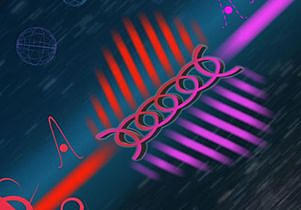The quantum mechanical entanglement of particles plays an important role in many technical applications. To date, however, the effect has been difficult to measure experimentally.
Physicists from the Technical University of Munich (TUM), the University of Innsbruck and the Institute of Photonic Sciences (ICFO) in Barcelona have now developed a new protocol to detect entanglement of many-particle quantum states using established measuring methods.
In quantum theory, interactions between particles create fascinating correlations known as entanglement. They cannot be explained by any means known to the classical world.
Entanglement is a consequence of the probabilistic rules of quantum mechanics and seems to permit a peculiar instantaneous connection between particles over long distances that defies the laws of our macroscopic world – a phenomenon that Einstein referred to as “spooky action at a distance.”
Developing protocols to detect and quantify entanglement of many-particle quantum states is a key challenge for current experiments because entanglement becomes very difficult to study when many particles are involved. “We are able to control smaller particle ensembles well, where we can measure entanglement in a relatively straight forward way,” says quantum physicist Philipp Hauke. However, “when we are dealing with a large system of entangled particles, this measurement is extremely complex or rather impossible because the resources required scale exponentially with the system size.
”Markus Heyl from the Technical University of Munich, Philipp Hauke and Peter Zoller from the Department of Theoretical Physics at the University of Innsbruck and the Institute for Quantum Optics and Quantum Information (IQOQI) at the Austrian Academy of Sciences in collaboration with Luca Tagliacozzo from the Institute of Photonic Sciences in Barcelona (Spain) have found a new way to detect certain properties of many-particle entanglement independent of the size of the system and by using standard measurement tools.
Entanglement measurable via susceptibility
“When dealing with more complex systems, scientists had to carry out a large number of measurements to detect and quantify entanglement between many particles,” says Philipp Hauke. “Our protocol avoids this problem and can also be used for determining entanglement in macroscopic objects, which was nearly impossible until now.”
Using this new method, physicists can employ tools already well established experimentally. In their study published in Nature Physics the team of researchers gives explicit examples to demonstrate its framework: The entanglement of many-particle systems trapped in optical lattices can be determined using laser spectroscopy while the well-established technique of neutron scattering is utilized for measuring entanglement in solid-state systems.
The physicists successfully demonstrated that the quantum Fisher information, which can provide reliable proof for genuine multipartite entanglement, is in fact measurable. The researchers emphasize that entanglement can be detected by measuring the dynamic response of a system to a perturbation, which can be determined by comparing individual measurements.
“For example, when we move a sample through a time-dependent magnetic field, we can determine the system’s susceptibility towards the magnetic field through the measurement data and thereby detect and quantify internal entanglement,” explains Hauke.
Manifold applications
Quantum metrology, i.e. measurement techniques with increased precision exploiting quantum mechanics, is not the only important field of application of this protocol. It will also provide new perspectives for quantum simulations, where quantum entanglement is used as a resource for studying properties of quantum systems.
In solid-state physics, the protocol may be employed to investigate the role of entanglement in many-body systems, thereby providing a deeper understanding of quantum matter. The research work was supported by the European Community, the European Research Council (ERC), the Austrian Science Fund, the Spanish Government and the German National Academy of Sciences Leopoldina.
Publication:
Measuring multipartite entanglement via dynamic susceptibilities. Philipp Hauke, Markus Heyl, Luca Tagliacozzo, Peter Zoller. Advanced Online Publication, Nature Physics, on 21 March 2016. - DOI: 10.1038/nphys3700





